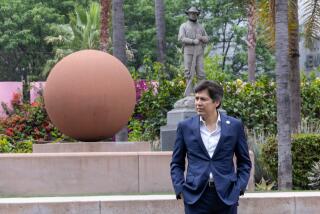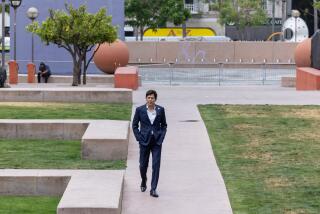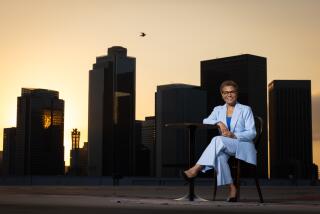UCLA Gallery Honors Life of Tom Bradley
- Share via
Tom Bradley, the first black mayor of Los Angeles, prided himself in uniting people across racial, economic, even geographic, boundaries. Under his 20-year tenure, whites became a minority in city government and women found a voice.
But at Thursday’s unveiling of the Tom Bradley Gallery at UCLA, close friends warned that Bradley’s work was in jeopardy.
The gallery, meant to pay tribute to Bradley’s 52 years of public service, now stands as a bittersweet reminder of what a mayor once dreamed for Los Angeles. Bradley died in 1998 at age 80.
“Bradley’s lifetime goals were to create paths of education for disadvantaged young people and encourage ethnic minorities to unite, to live cooperatively,” said Bill Elkins, Bradley’s special assistant when he was mayor, from 1973 to 1993. “We want that message displayed at a time when tension between ethnicities is evident.”
Elkins points to the clashes between black and Latino students at South Los Angeles high schools. In February, racial brawls spread throughout county jails.
Meanwhile, college enrollment rates of blacks and Latinos wane.
In April, UCLA officials announced a drop in black, Latino and Native American student enrollment, from 16.5% last year to 15.2% this year.
Two other UC campuses, Merced and San Diego, posted smaller drops.
“We are looking at a crisis in education unlike anything I’ve ever seen in the last 40 years,” Elkins said.
Maury Weiner, chairman of the Tom Bradley Legacy Foundation, said the late mayor “would be terribly disappointed” with the state of minority education in Los Angeles today.
Bradley would be “doing whatever he could to increase the participation of minorities in every grade, in every school,” Weiner said. “That is something we’re now working very hard to achieve for him.”
The foundation announced Thursday a new partnership with the UC system to help disadvantaged students graduate from high school and attend college in California.
The Tom Bradley Leadership Institute will provide summer leadership seminars to disadvantaged high school students, particularly blacks and Latinos. The UC system and 10 community groups will provide them with tutoring in algebra, a required subject that has posed a challenge for many black and Latino students trying to graduate from high school.
Elkins said the institute is also working on a number of college scholarships, preferably for students attending Bradley’s alma mater, UCLA.
Janina Montero, UCLA’s vice chancellor of student affairs, blames the enrollment drop on Proposition 209, a 1996 voter-approved initiative that prevents UCLA and other universities from considering race in admissions.
“We are very, very concerned about this, and we certainly welcome the foundation’s help very much so,” she said.
In a way, the institute will pick up where Bradley left off. In 1988, he created LA’s BEST, an after-school program that provides safe places for children to learn until their parents come home from work.
Bradley’s mother was a single parent who worked long hours as a domestic maid to support her five children.
On Thursday, a room connected to Bradley’s gallery was decorated with artwork by the children of LA’s BEST.
In the main gallery, seven glass cases protect other memorabilia from Bradley’s years in public service.
One case is dedicated to Bradley’s stint as the city’s longest-serving mayor. Another showcases his 21 years with the Los Angeles Police Department. A third case is dedicated to the 1984 Summer Olympics, which he helped bring to Los Angeles.
But many who worked with Bradley say the four remaining cases are what truly embody the modest -- sometimes stoic -- mayor.
Medals, plaques and oversized keys to cities such as Milan, Italy, and Koohsiung, South Korea, stand side-by-side in the cases. Above them hang pictures of Bradley with some of the world’s most influential leaders, including Nelson Mandela and Pope John Paul II.
“Foreign leaders who had never before traveled to Los Angeles came to see the mayor,” Weiner said. “That was one of the keys to his success. He built trust and cohesive relationships.”
At the gallery opening, international figures such as Zhong Jianhua, consul general in Los Angeles of the People’s Republic of China, joined with local leaders, including Mayor Antonio Villaraigosa and City Councilman Tom LaBonge.
“He developed a lot of friendships, not just locally, but internationally,” Jianhua said.
Still, the absence of one group, college students, didn’t go unnoticed.
“They’re too young to remember him, but they’re the beneficiaries of his work,” said Daniel Neuman, executive vice chancellor of UCLA.
Perhaps, while passing through the gallery, “students will be energized by the story of this man,” he said.
Being a “Bradley fan,” Villaraigosa said, he was eager to browse the gallery, which has a picture of him posing with the former mayor. Villaraigosa called Bradley “L.A.’s greatest mayor,” one who paved the way for his own success.
“I’m here on the shoulders of a great man,” he said. “I owe a debt of gratitude to Tom Bradley who suffered indignities, who was willing to climb the mountain and reach the impossible dream of being the mayor of all people.”
In one of the cases lies a newspaper article titled “Bradley Banks on His Ability to Unite People.” It was written during Bradley’s first mayoral campaign against incumbent Sam Yorty.
“I think I’ve always had an ability to bring people together, to create an atmosphere in which the problems can be solved instead of being further inflamed,” Bradley said in the article. “I think that we can deliver people from that kind of animosity, kind of hatred that’s unknowing, that separates us by the invisible barriers of race, religion or economic status. I believe that we can make this city and this nation great.”
More to Read
The biggest entertainment stories
Get our big stories about Hollywood, film, television, music, arts, culture and more right in your inbox as soon as they publish.
You may occasionally receive promotional content from the Los Angeles Times.










